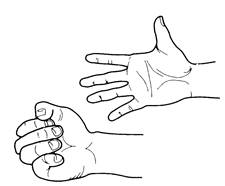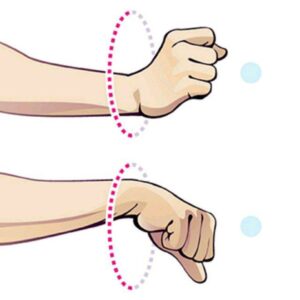Hand pain can be a real obstacle, right? Whether it’s from hours of typing, lifting heavy things, or even just the daily wear and tear, hand pain can really slow you down. But here’s the good news—relief is possible! An orthopedic surgeon can help you figure out what’s causing the pain and provide treatments to get you back to your normal routine.
In this blog, we’ll talk about how an orthopedic doctor can help treat hand pain and when you should consult one. We’ll also show you how to find a specialist who can guide you on the path to recovery. So, if your hands are giving you trouble, keep reading—we’ve got all the information you need to find the right help and start feeling better!
Contents
Why Is My Hand Aching? Common Causes
 Hand pain is something many of us experience at some point, but it can often feel like a mystery. Why does it happen? What’s causing the discomfort? Let’s look at some of the most common reasons behind hand pain that you might encounter from everyday activities:
Hand pain is something many of us experience at some point, but it can often feel like a mystery. Why does it happen? What’s causing the discomfort? Let’s look at some of the most common reasons behind hand pain that you might encounter from everyday activities:
-
Carpal Tunnel Syndrome
If you’ve been typing, using a mouse, or doing repetitive tasks for long periods, you might develop carpal tunnel syndrome. It happens when the median nerve in your wrist gets compressed, leading to numbness, tingling, and pain, especially in the thumb, index, and middle fingers. -
Arthritis
Osteoarthritis or rheumatoid arthritis can affect the joints in your hands, causing pain, swelling, and stiffness. -
Tendonitis
Tendonitis occurs when the tendons in your hand or wrist become inflamed due to overuse. It’s common in people who perform repetitive movements, like athletes, office workers, or anyone who lifts heavy objects regularly. -
Fractures or Sprains
Injuries like fractures or sprains in the hand or wrist can lead to sudden, sharp pain. -
Trigger Finger
If you’ve noticed a “locking” or “catching” feeling when you try to straighten your finger, you might have trigger finger. This occurs when the tendons that control the fingers become swollen, making movement difficult and painful. -
Ganglion Cysts
Small, fluid-filled lumps known as ganglion cysts can form on the wrist or hand joints. Though they’re usually harmless, they can cause discomfort or even limit your ability to move your hand freely. -
Overuse or Poor Posture
Spending long hours in certain positions—like holding your phone, texting, or playing video games—can lead to repetitive stress injuries in the hands. These can cause pain in the joints, tendons, and muscles over time.
While the causes of hand pain can vary, recognizing the symptoms early on can help you find the right treatment and get back to doing the things you love. If you’re experiencing ongoing pain or discomfort, it might be time to see an orthopedic specialist who can pinpoint the cause and recommend the right treatment.
How Can an Orthopedic Doctor Help with My Hand Pain?
 An orthopedic doctor is a specialist in diagnosing and treating conditions related to bones, joints, and muscles. If you’re experiencing hand pain, here’s how an orthopedic doctor can help:
An orthopedic doctor is a specialist in diagnosing and treating conditions related to bones, joints, and muscles. If you’re experiencing hand pain, here’s how an orthopedic doctor can help:
-
Diagnosis
The doctor will start by examining your hand and asking about your symptoms. They may recommend tests like X-rays or MRIs to determine the exact cause of your pain. -
Non-Surgical Treatments
Orthopedic specialists often start with non-surgical treatments, such as medications, physical therapy, or splints to reduce pain and inflammation, improve function, and prevent further injury. -
Surgical Treatments
If non-surgical methods don’t provide relief, surgery might be considered, especially in cases like tendon injuries, fractures, or severe arthritis. Surgeries like carpal tunnel release or joint replacement can offer long-term pain relief and restore function.
An orthopedic doctor can guide you through the most effective treatment options to help alleviate your hand pain, whether through conservative methods or surgical intervention when necessary.
How Does an Orthopedic Surgeon Diagnose Hand Pain?
 When you visit an orthopedic surgeon for hand pain, the first step is a detailed physical exam. The doctor will ask about your symptoms, such as when the pain started, its intensity, and any activities that might have triggered it. They will also check for visible signs like swelling, bruising, or deformities and test the hand’s range of motion and strength to see how much movement causes pain.
When you visit an orthopedic surgeon for hand pain, the first step is a detailed physical exam. The doctor will ask about your symptoms, such as when the pain started, its intensity, and any activities that might have triggered it. They will also check for visible signs like swelling, bruising, or deformities and test the hand’s range of motion and strength to see how much movement causes pain.
If necessary, the orthopedic surgeon may recommend imaging tests to get a clearer picture of what’s happening inside. X-rays are commonly used to check for bone-related issues like fractures, arthritis, or joint degeneration. For soft tissue problems like ligament tears or tendonitis, an MRI is more effective, providing detailed images of the tendons, muscles, and ligaments in your hand. In some cases, an ultrasound may also be used to look at soft tissues in real-time.
Once the surgeon has all the necessary information, they’ll provide an accurate diagnosis and develop a treatment plan, whether it’s through physical therapy, medications, or possibly surgery, depending on the severity of the condition.
Simple Exercises to Ease Hand Pain at Home
Here are some easy exercises you can do at home to help relieve hand pain and improve mobility:
Wrist Flexor Stretch
- Extend one arm with the palm facing up.
- Use the other hand to gently pull the fingers back towards your body.
- Hold for 20-30 seconds, then switch hands.
- Benefit: Relieves tension in the wrist and forearm, improving flexibility.

Fist Clench and Release
- Extend your fingers out as wide as possible.
- Slowly curl your fingers into a fist and hold for a few seconds.
- Release and repeat 10-15 times.
- Benefit: Strengthens hand muscles, improves blood circulation, and reduces stiffness.

Finger Lifts
- Place your hand flat on a table with your palm down.
- Lift each finger one at a time, hold for a few seconds, and lower it.
- Repeat for all fingers.
- Benefit: Improves strength and flexibility of each individual finger.

Thumb Stretch
- Hold your hand out with fingers spread wide.
- Gently pull your thumb back towards your wrist.
- Hold for 20-30 seconds, then switch hands.
- Benefit: Targets thumb and wrist, relieving tension and increasing range of motion.

Tendon Glides
- Start with your fingers straight.
- Bend your fingers into a hook position, then make a full fist.
- Open your hand and straighten your fingers.
- Repeat 10-15 times.
- Benefit: Improves tendon mobility and reduces stiffness in fingers and wrists.

Wrist Circles
- Extend your arms in front and rotate your wrists in circles (clockwise, then counterclockwise).
- Do 10-15 circles in each direction.
- Benefit: Promotes joint flexibility and reduces stiffness in wrists.

These exercises, done daily, can reduce pain and increase mobility. Always listen to your body, and consult an orthopedic specialist if pain persists.
When Should I See a Specialist for Hand Pain?
 If you’re experiencing any of the following symptoms, it may be time to consult an orthopedic specialist:
If you’re experiencing any of the following symptoms, it may be time to consult an orthopedic specialist:
- Persistent Pain that doesn’t improve with rest or over-the-counter medication.
- Swelling around the joints or tendons in the hand that doesn’t go down.
- Numbness or Tingling in the fingers or hand.
- Difficulty Moving Your Hand or Fingers, especially if it interferes with daily tasks.
- Weakness in the Hand, making it hard to grip or lift objects.
- Visible Deformities or changes in the shape of your hand or fingers.
- Pain that worsens with activity or after using the hand for long periods.
- Pain after an Injury that doesn’t improve after a few days or gets worse over time.
If any of these signs sound familiar, it’s best to see a specialist to get a proper diagnosis and start treatment as soon as possible.
Where Can I Find an Orthopedic Doctor for My Hand Pain?
Finding the right orthopedic doctor is key to getting proper treatment for your hand pain. Here’s how you can find a suitable specialist:
-
-
Many hospitals and clinics have orthopedic departments that focus on hand and wrist conditions. You can visit a local clinic or hospital to consult an experienced orthopedic doctor who specializes in hand pain.
-
Online platforms like MantraDoc offer a quick and convenient way to connect with orthopedic specialists from the comfort of your home. You can schedule an online consultation, discuss your symptoms, and receive expert advice.
-
At MantraDoc, we make it easy to get the care you need. Through our online platform, you can:
-
Book an online consultation with an orthopedic specialist specializing in hand pain.
-
Get expert advice on managing your condition and receive a personalized treatment plan.
-
Save time by consulting a doctor from the comfort of your home.
👉 Click here to book your online consultation with an orthopedic specialist today!
Finding the right doctor for your hand pain has never been easier. Whether you prefer an in-person visit or an online consultation, MantraDoc ensures you receive the best care tailored to your needs.

